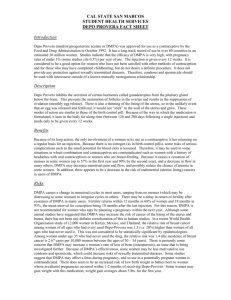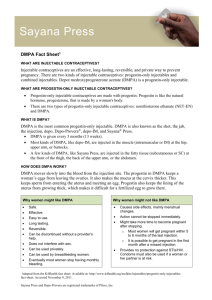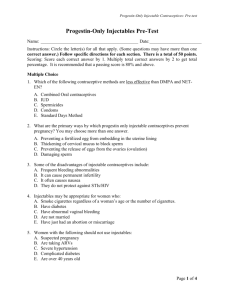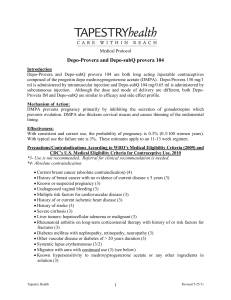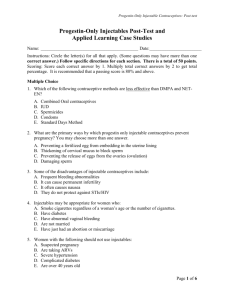For long term use of depot medroxyprogesterone acetate, there may
advertisement
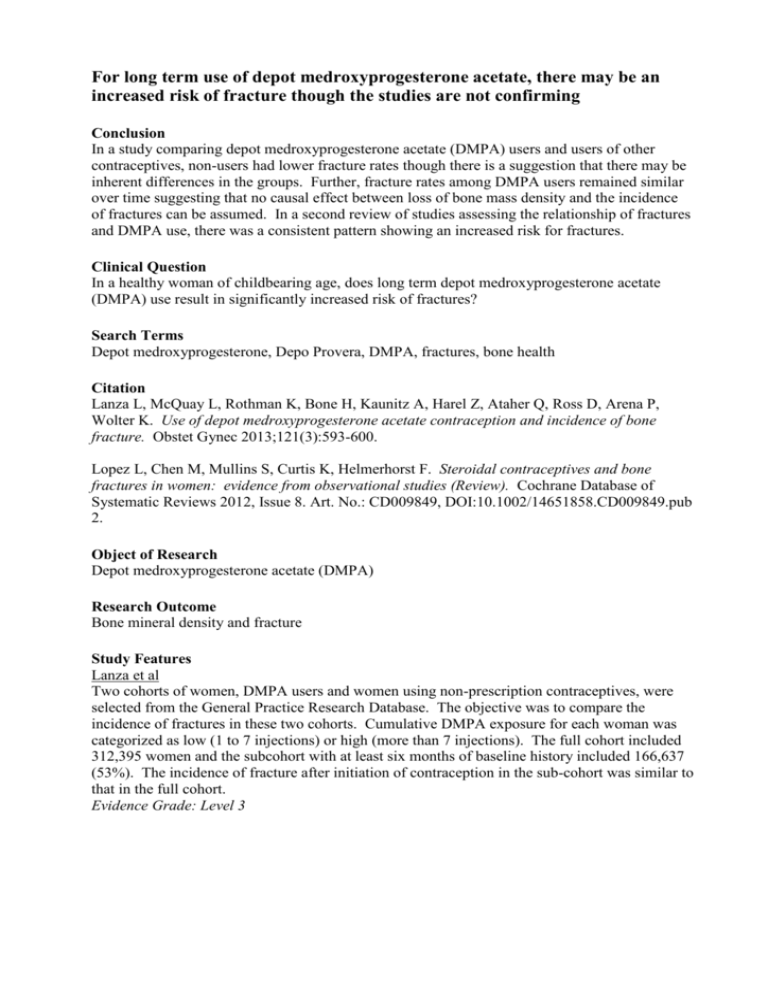
For long term use of depot medroxyprogesterone acetate, there may be an increased risk of fracture though the studies are not confirming Conclusion In a study comparing depot medroxyprogesterone acetate (DMPA) users and users of other contraceptives, non-users had lower fracture rates though there is a suggestion that there may be inherent differences in the groups. Further, fracture rates among DMPA users remained similar over time suggesting that no causal effect between loss of bone mass density and the incidence of fractures can be assumed. In a second review of studies assessing the relationship of fractures and DMPA use, there was a consistent pattern showing an increased risk for fractures. Clinical Question In a healthy woman of childbearing age, does long term depot medroxyprogesterone acetate (DMPA) use result in significantly increased risk of fractures? Search Terms Depot medroxyprogesterone, Depo Provera, DMPA, fractures, bone health Citation Lanza L, McQuay L, Rothman K, Bone H, Kaunitz A, Harel Z, Ataher Q, Ross D, Arena P, Wolter K. Use of depot medroxyprogesterone acetate contraception and incidence of bone fracture. Obstet Gynec 2013;121(3):593-600. Lopez L, Chen M, Mullins S, Curtis K, Helmerhorst F. Steroidal contraceptives and bone fractures in women: evidence from observational studies (Review). Cochrane Database of Systematic Reviews 2012, Issue 8. Art. No.: CD009849, DOI:10.1002/14651858.CD009849.pub 2. Object of Research Depot medroxyprogesterone acetate (DMPA) Research Outcome Bone mineral density and fracture Study Features Lanza et al Two cohorts of women, DMPA users and women using non-prescription contraceptives, were selected from the General Practice Research Database. The objective was to compare the incidence of fractures in these two cohorts. Cumulative DMPA exposure for each woman was categorized as low (1 to 7 injections) or high (more than 7 injections). The full cohort included 312,395 women and the subcohort with at least six months of baseline history included 166,637 (53%). The incidence of fracture after initiation of contraception in the sub-cohort was similar to that in the full cohort. Evidence Grade: Level 3 Lopez et al This is a review of cohort and case control studies involving steroidal contraceptives and the risk of fracture. Four studies involving depot medroxyprogesterone acetate were identified; two cohort studies and two case control studies though one of the cohort studies did not have a comparable cohort and is not referenced here. The studies were as follows: Kaunitz 2010: This is a cohort study which included women using DMPA before age 50 and using the UK based General Practice Research Database. Interventions were users of DMPA versus other hormonal contraceptives. The primary outcome was incident fractures. Meir 2010: This is a case control study using the UK based General Practice Research Database. Interventions were users of DMPA versus other hormonal contraceptives. The primary outcome was incident first time fractures. Vestergaard 2006: This is a case control study in Demark using the National Hospital Discharge Register. The study includes DMPA users and nonusers of DMPA. The primary outcome was fractures sustained in the year 2000. Evidence Grade: Level 2 The Evidence Lanza et al Before starting their contraceptive, the crude fracture rate for DMPA users was 8.4 per 1000 person-years as compared to non-DMPA users of 6.6 per 1000 person years. The difference was statistically significant. After starting their contraceptive, the crude fracture rate was 7.3 per 1000 person-years for non-use of DMPA and 9.1 per 1000 person-years during DMPA use. The crude incidence rate ratio was 1.37 (95% CI: 1.29-1.45) and the crude incidence rate difference was 2.42 per 1000 person-years (95% CI: 1.94-2.91). Although DMPA users had a higher fracture risk than nonusers, the risk did not increase after DMPA was initiated nor did the fractures in the DMPA group correlate with done mass density lose. Lopez et al Kaunitz 2010: Overall, DMPA users had a greater risk of fractures with an incident rate ratio of 1.44 (95% CI: 1.38 – 1.50). Meier 2010: Current and past users of DMPA were more likely to have a fracture than non users. The odds increased slightly with the number of prescriptions. Vestergaard 2006: DMPA ever users were slightly more likely to have a fracture than non users. Appraised by: The Jordan Evidence Based Medicine-Reproductive Health Group Update by: 16 March 2016
